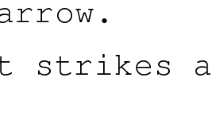Abstract
We present a logical calculus extending the classical propositional calculus with an additional connective which has some features of substructural logic. This results in a logic which seems to be suitable for reasoning with ambiguity. We use a Gentzen style proof theory based on multi-contexts, which allow us to have two ways to combine formulas to sequences. These multi-contexts in turn allow to embed both features of classical logic as well as substructural logic, depending on connectives, which would be impossible with simple sequents. Finally, we present an algebraic semantics and a completeness theorem.
Access this chapter
Tax calculation will be finalised at checkout
Purchases are for personal use only
Similar content being viewed by others
Notes
- 1.
This roughly distinguishes ambiguity from cases of vagueness [10].
- 2.
Technically, this translation presupposes the existence of a boy, this however is irrelevant to our argument.
- 3.
Thanks to an anonymous reviewer for this example!.
- 4.
Actually, this would be a meta-metalanguage, because logical representations are already a form of representation of real meanings.
References
Atlas, J.D.: Philosophy without Ambiguity. Clarendon Library of Logic and Philosophy. Clarendon Press, Oxford (1989)
Dyckhoff, R., Sadrzadeh, M., Truffaut, J.: Algebra, proof theory and applications for a logic of propositions, actions and adjoint modal operators. Electr. Notes Theor. Comput. Sci. 286, 157–172 (2012)
Egg, M.: Semantic underspecification. Lang. Linguist. Compass 4(3), 166–181 (2010)
Kracht, M.: Mathematics of Language. Mouton de Gruyter, Berlin (2003)
Lahav, O., Avron, A.: A unified semantic framework for fully structural propositional sequent systems. ACM Trans. Comput. Log. 14(4), 27:1–27:33 (2013)
Lambek, J.: Cut elimination for classical bilinear logic. Fundam. Inform. 22(1/2), 53–67 (1995)
Maddux, R.: Relation Algebras. Elsevier, Amsterdam (2006)
Montague, R.: The proper treatment of quantification in ordinary English. In: Hintikka, J., Moravcsik, J.M.E., Suppes, P. (eds.) Approaches to Natural Language, pp. 221–242. Reidel, Dordrecht (1973)
Negri, S., von Plato, J.: Structural Proof Theory. Cambridge University Press, Cambridge (2001)
Pinkal, M.: Logic and Lexicon: The Semantics of the Indefinite. Kluwer, Dordrecht (1995)
Poesio, M.: Semantic ambiguity and perceived ambiguity. In: van Deemter, K., Peters, S. (eds.) Semantic Ambiguity and Underspecification, pp. 159–201. CSLI Publications, Stanford (1994)
Restall, G.: An Introduction to Substructural Logics. Routledge, New York (2008)
Sennet, A.: Ambiguity. In: Zalta, E.N. (ed.) The Stanford Encyclopedia of Philosophy, Spring 2016 edn. Metaphysics Research Lab, Stanford University (2016)
Wurm, C., Lichte, T.: The proper treatment of linguistic ambiguity in ordinary algebra. In: Foret, A., Morrill, G., Muskens, R., Osswald, R., Pogodalla, S. (eds.) FG 2015-2016. LNCS, vol. 9804, pp. 306–322. Springer, Heidelberg (2016). https://doi.org/10.1007/978-3-662-53042-9_18
Author information
Authors and Affiliations
Corresponding author
Editor information
Editors and Affiliations
Rights and permissions
Copyright information
© 2018 Springer-Verlag GmbH Germany
About this paper
Cite this paper
Wurm, C. (2018). The Logic of Ambiguity: The Propositional Case. In: Foret, A., Muskens, R., Pogodalla, S. (eds) Formal Grammar . FG 2017. Lecture Notes in Computer Science(), vol 10686. Springer, Berlin, Heidelberg. https://doi.org/10.1007/978-3-662-56343-4_6
Download citation
DOI: https://doi.org/10.1007/978-3-662-56343-4_6
Published:
Publisher Name: Springer, Berlin, Heidelberg
Print ISBN: 978-3-662-56342-7
Online ISBN: 978-3-662-56343-4
eBook Packages: Computer ScienceComputer Science (R0)




